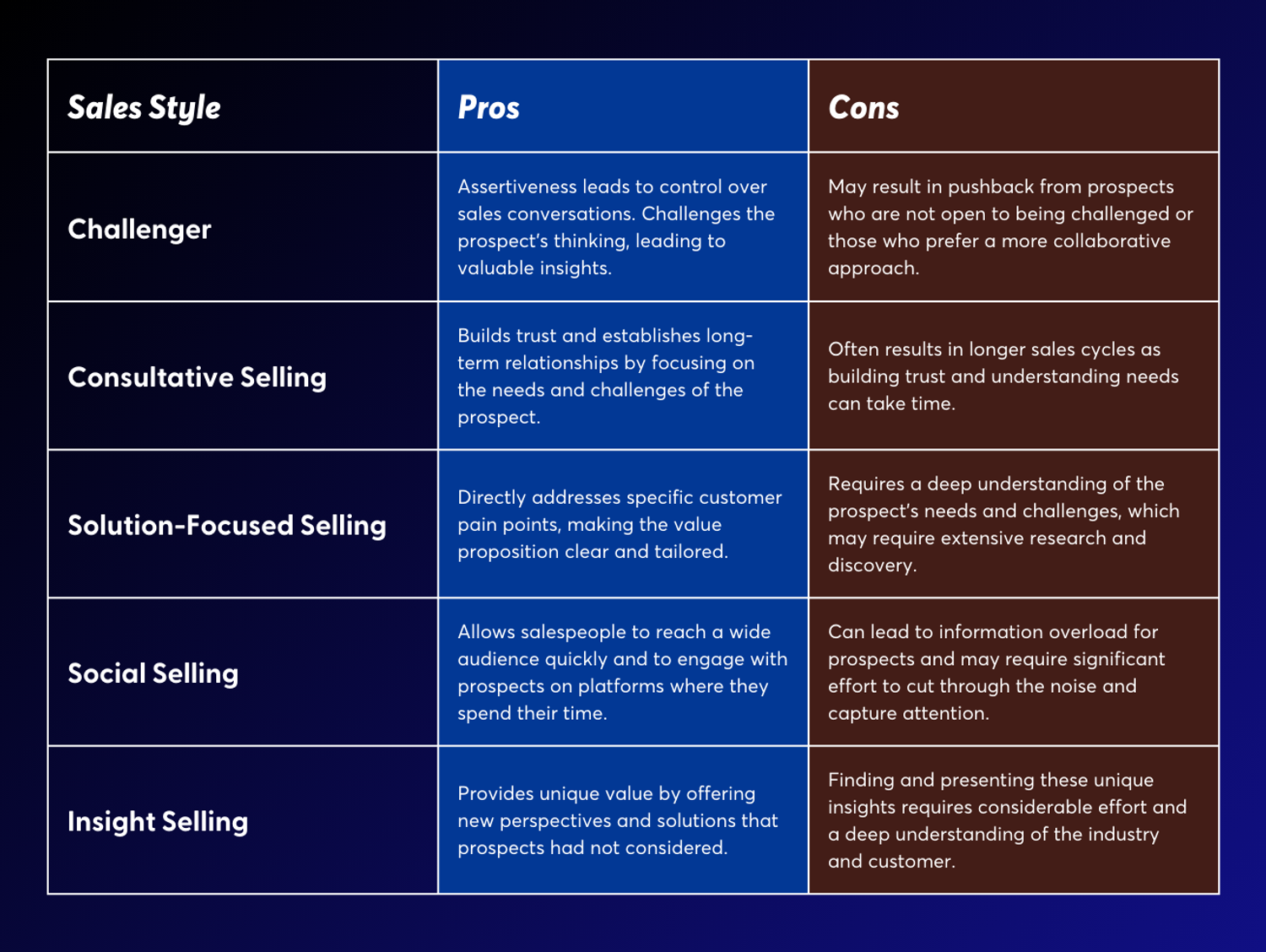Struggling to close more deals?
You're not alone. The book "The Challenger Sale" introduces a game-changing sales method.
This article will reveal effective strategies that promise better results in your sales journey.
Key Takeaways
- The Challenger method revolutionizes traditional sales by challenging clients with new solutions, especially effective during economic downturns.
- Consultative selling and solution-focused strategies build stronger, long-term relationships by assessing and addressing the specific needs of customers.
- Social selling utilizes social media platforms for more personalized engagement, while insight selling offers unique perspectives to meet customer challenges.
- Understanding various sales styles allows professionals to tailor their approach, increasing success rates in deal closures.
- Choosing the right sales style involves aligning with your business goals, understanding your customers' needs, and leveraging strengths within your team.
Also read: Outbound Sales Strategies That Work + 5 Best Practices
6 Sales Styles and Techniques for 2024
Exploring new sales styles and techniques for 2024 will equip you with the tools needed to thrive in an evolving market. These innovative strategies are designed to enhance your negotiation skills, improve customer rapport, and boost deal closure rates.
1. Challenger method
The Challenger method turns traditional sales on its head by focusing on teaching, tailoring, and taking control of sales conversations. This approach pushes the envelope by introducing constructive tension into discussions with potential clients.
Salespeople using this method aim to challenge customers' thinking, presenting new solutions that they hadn't considered before. They don't just respond to needs; they redefine them.
By doing so, they position themselves as invaluable advisors rather than mere vendors.
With roots in "The Challenger Sale" book, this strategy shines especially during economic downturns where fear and uncertainty prevail. It leverages a deep understanding of customer challenges to offer compelling, problem-solving sales pitches that speak directly to the current climate's concerns.
Leaders in strategic selling use assertive communication and negotiation tactics effectively within this framework to close deals even when budgets tighten.
Moving forward, let's delve into consultative selling and how it complements or differs from the challenger method in meeting customer needs.
2. Consultative selling
Consultative selling transforms salespeople into trusted advisors. It leverages active listening, a keen needs assessment, and deep product knowledge to tailor solutions that precisely match the customer's situation.
Sales reps position themselves as subject matter experts by combining their understanding of the customer's industry with comprehensive insights into how their products can address specific challenges.
This approach isn’t about pushing a product but rather about building a solution together with the client.
This sales style hinges on customization and support after the sale, ensuring clients feel valued and supported long-term. Collaboration with technical and product teams enhances the rep’s capability to propose customized solutions, making consultative selling vital for maintaining strong relationships.
By focusing on customer analysis and long-term relationship building, sales professionals using this method not only close deals but also set the stage for future opportunities.
3. Solution-focused
Moving from the consultative approach, solution-focused selling zeroes in on addressing the specific problems and needs of prospects. This method operates through a deep dive into understanding what truly matters to customers, thereby crafting tailored solutions that not only meet but exceed their expectations.
Salespeople engage closely with their company's technical and product teams to ensure that proposals are both feasible and innovative, demonstrating a commitment to delivering results-driven solutions.
This collaborative process relies heavily on open communication between sales professionals and clients, fostering an environment where co-creation of solutions becomes the norm. By prioritizing problem-solving and focusing on satisfying customer needs, this approach strengthens long-term relationships.
It moves beyond merely closing deals to creating value for clients, positioning salespeople as trusted advisors rather than just vendors, a hallmark of partnership selling. The essence of solution-focused selling lies in its ability to transform challenges into opportunities by leveraging teamwork and client-focused strategies for sustainable success.
4. Relationship building
In relationship building, salespeople focus on creating strong, lasting connections with customers, which is a critical aspect of partnership selling. This approach relies heavily on trust-building, customer relations, and partnership development.
Establishing these genuine relationships leads to increased customer loyalty, more repeat business, and valuable referrals. Engaging clients through consultative selling and effective relationship management encourages them to see salespeople not just as vendors but as trusted advisors.
Collaboration plays a crucial role in this process. It involves open communication and the co-creation of solutions that serve shared goals. By focusing on problem-solving and prioritizing long-term value for customers, sales professionals build a foundation for sustained success.
This strategy not only enhances client engagement but also significantly boosts customer retention rates by providing personalized experiences that meet individual needs and preferences.
5. Social selling
Social selling has reshaped the landscape of sales strategies, leveraging social media platforms like LinkedIn, Twitter, Facebook, Instagram, and TikTok. Sales professionals now prioritize building a strong online presence to connect with potential clients.
This method focuses on prospecting and lead generation through digital channels, allowing for more personalized and direct engagement with prospects.
Effective social selling involves creating tailored outreach messages that resonate with target audiences. It calls for active participation in social networking to maintain visibility and relevance in your industry.
Sales representatives use tracking and analytics tools to measure their success and adjust strategies accordingly. By engaging prospects through thoughtful content and interactions, sellers build trust and relationships that pave the way for successful deals.
6. Insight selling
Insight selling sets the stage for a deeper understanding of your prospects' needs and challenges. It involves shedding light on valuable insights that prospects might not have considered before, making it a powerful tool in today's sales arsenals.
Salespeople can unlock new perspectives for their clients, sparking those vital "Aha" moments that turn possibilities into solutions. This method pushes beyond mere product features to explore the real value and benefits of solutions tailored to specific problems.
Crafting unique insights requires thorough research and a keen understanding of industry trends, customer pain points, and potential opportunities. By presenting these findings effectively, salespeople position themselves as trusted advisors rather than just vendors.
This approach fosters stronger relationships with prospects by demonstrating a genuine interest in addressing their unique needs and goals.
Insight-led selling encourages customers to see beyond their current situation, laying the groundwork for more meaningful conversations around how your solution can genuinely make a difference in achieving their objectives.
3 Types of Selling to Avoid
Understanding which sales styles could hinder your success is crucial for any salesperson. Recognizing these ineffective methods helps steer clear towards strategies that foster better customer relationships and deals.
1. Aggressive sales styles
Aggressive sales styles thrive on assertiveness, persistence, and a laser focus on hitting sales goals. Salespeople using these tactics tend to push their agenda more than listening to the customer's needs.
This approach can be off-putting and is often seen as outdated in today’s market where buyer experience holds increasing value. Customers may feel pressured rather than understood, leading them away from closing a deal.
Such strategies fail especially in complex B2B cycles where relationships and trust are key to closing deals. The aggressive method neglects the importance of aligning solutions with customer needs, favoring immediate gains over long-term relationships.
As we move forward, it’s clear that adapting more consultative and solution-focused techniques could serve salespeople better in achieving sustainable success.
Next we explore why transactional selling falls short in building meaningful customer engagements.
2. Transactional selling
Transactional selling turns the spotlight on quick sales and is all about completing individual transactions. It often pushes products into the limelight, focusing more on making a sale than on who is buying or why they might need it.
This approach leans heavily towards short-term gains, typically employing high-pressure tactics to close deals swiftly. While it may sound efficient, this method risks overlooking the deeper needs of customers, favoring one-time sales over lasting relationships.
Given its product-focused nature, transactional selling finds itself at odds with complex B2B sales cycles which demand a more nuanced understanding of client needs and longer nurture periods.
This traditional selling style rests on the assumption that customers are primarily interested in the features or price of a product rather than its potential impact or integration within their operations.
As such, while it can rack up numbers quickly in specific markets or scenarios, it falls short in environments where trust and consultative dialogue, a key feature of solution selling, pave the way for success.
3. "Spray and pray" approach
The "spray and pray" approach relies heavily on sending out generic marketing messages to a broad audience, hoping for a few responses. Sales people often use cold calling and mass emailing as tools in this strategy, flooding potential customers' inboxes with one-size-fits-all messages.
This method puts the product before the person, focusing more on making a sale than addressing the customer's needs or problems. It adopts an aggressive sales technique that can come across as pushy and impersonal.
This style falls short in complex B2B sales cycles where personalization and understanding of the customer’s unique challenges are key. Emphasizing sales goals over building relationships, it fails to prioritize the buyer's needs, leading to lower engagement rates.
The approach is characterized by high-pressure selling tactics that may alienate potential clients rather than draw them in. Effective sales strategies require more than just persistence; they demand a thoughtful understanding of who the customers are and what they truly need.
Key Elements of Effective Sales Styles
Understanding the core elements of effective sales styles, such as adapting to customer needs and enhancing negotiation skills, can significantly boost your ability to close more deals.
1. Characteristics of challenger style
The challenger style stands out due to its combination of being assertive and persuasive, aiming to shake the customer's current beliefs.
Salespeople using this approach focus on educating clients about unknown issues or opportunities, which is known as "Teaching." They tailor their message specifically for each client, making sure it resonates with their unique challenges and needs.
This customization shows a deep understanding of the client's business, elevating the salesperson from a vendor to a trusted advisor.
Challengers take control of the sale process by confidently leading conversations towards conclusions that challenge clients' assumptions but in a constructive way. They employ "Constructive Tension" as a technique to provoke thought without offending, sparking curiosity and engagement from potential buyers.
Their authoritative stance pushes customers out of comfort zones into realizing new solutions that they hadn't considered before. This method is especially impactful during times of recession when fear and uncertainty dominate decision-making processes, proving why it gained popularity through "The Challenger Sale" book.
2. Consultative selling positioning
Moving from the direct approach of the challenger style, consultative selling shifts the focus towards establishing a deeper connection with clients. Sales representatives take on the role of subject matter experts who not only understand their product inside out but also excel in uncovering and addressing customer needs.
This method relies heavily on active listening, allowing salespeople to perform a thorough needs assessment that identifies exactly what solution would best suit each client.
This strategy stands firm on building relationships through personalized interactions. Sales experts dive deep into problem-solving, crafting customized solutions that go beyond mere transactions.
They prioritize adding value at every step, from initial consultation to postsale support, ensuring customers feel understood and valued. With consultative selling, the emphasis is on long-term client satisfaction rather than quick deals, laying down a foundation for sustained success in today's competitive market.
3. Collaboration in solution-focused selling
Collaborating with the company's technical and product teams proves crucial in solution-focused selling. This method hinges on open communication, ensuring all parties have a clear understanding of customer needs and objectives.
Through this cooperation, salespeople can co-create solutions that truly address the client’s problems. Such partnership not only solves immediate issues but also lays the groundwork for long-term relationships.
Engagement and joint effort form the backbone of effective collaboration in this sales style. With shared goals, problem-solving becomes a collective mission rather than an individual challenge.
This synergy among team members boosts creativity and leads to innovative solutions that stand out in the market. Next, let's delve into building genuine connections in relationship selling.
4. Building genuine connections in relationship selling
Transitioning from solution-focused selling, we move into the realm of building genuine connections in relationship selling. This strategy emphasizes trust-based and customer-centric approaches.
Salespeople prioritize understanding their customers' needs, values, and challenges. They tailor their communication to meet these individual requirements, fostering authentic connections.
This approach leads to deeper loyalty and encourages repeat business along with referrals. By emphasizing empathy in sales interactions and focusing on long-term relationship building rather than immediate transactions, sales professionals create a foundation for sustained success.
Demonstrating genuine interest in clients’ successes translates into stronger partnerships that benefit both parties over time.
5. Strategies for successful social selling
To excel in social selling, start by crafting a strong online presence on platforms like LinkedIn, Twitter, and Instagram. This approach allows you to connect more effectively with potential leads.
Use tools such as LinkedIn's Sales Navigator to find and engage with prospects that match your target audience criteria. Personalizing your outreach will set you apart from competitors and capture the interest of potential clients.
Engage actively with prospects through comments and shares, showing genuine interest in their needs and challenges. Tailor your communication to address these specific issues, demonstrating how your product or service can provide solutions.
Tracking interactions using data analysis tools will help refine your strategy over time, ensuring you nurture leads more successfully into customers. Remember, consistent relationship building through personalized communication is key to converting online connections into real-world sales opportunities.
6. Providing unique insights in insight selling
Insight selling urges salespeople to go beyond the surface, uncovering clients' hidden needs and challenges.
This approach demands a deep understanding of industry trends, customer behaviors, and potential solutions that can transform a prospect's business or personal goals.
These unique insights position them as trusted advisors rather than mere vendors.
Crafting these insights requires thorough research, keen observation, and the ability to connect seemingly disparate pieces of information into a coherent whole. Sales reps use their knowledge and analysis skills to craft compelling stories that resonate with their clients' specific circumstances.
Through this strategic narrative, they highlight the benefits of their solutions in addressing previously unidentified issues or optimizing existing processes. This method not only facilitates problem-solving but also enhances the value proposition offered to each client, making insight selling an invaluable component in modern sales strategies.
Pros and Cons of Different Sales Styles
Exploring the various sales styles reveals a spectrum of strategies, each with its unique advantages and challenges. These styles cater to different selling situations and buyer personalities, making it crucial for sales professionals to understand their pros and cons.
Below is a detailed examination of these sales styles in a comprehensive format.

Understanding these styles helps sales professionals tailor their approach to match the buying journey of their prospects, thereby increasing the chances of successful deal closure.
Each style has its context where it excels, and knowing when and how to apply them is key to a versatile and effective sales strategy.
Choosing the Right Sales Style for Your Business
Choosing the right sales style for your business requires a deep understanding of your ideal customer profile and the unique attributes of your product or service.
Consider factors like the sales cycle length, strengths and weaknesses within your sales team, and how you want your brand to be perceived in the market.
Matching these aspects with a suitable selling method—be it consultative selling for complex solutions or relationship building for markets valuing personal connections—can significantly enhance your sales effectiveness.
Analyze key elements such as customer relationship management strategies, negotiation tactics, and product positioning to ensure that the selected sales approach aligns with overall business objectives.
Effective selection contributes to improved customer profiling accuracy and more dynamic sales team dynamics, leading directly into developing top-notch sales skills necessary for success.
Strategies for Developing Sales Skills
Developing strong sales skills is crucial for success in the competitive world of sales. Implementing the right strategies can significantly enhance your ability to close deals and build lasting relationships with clients.
Here are several effective strategies for polishing your sales competencies:
- Dive into reading sales books: Sales books are treasure troves of knowledge, providing insights into effective techniques and strategies used by successful salespeople. They offer a range of perspectives that can inspire new approaches to selling.
- Seek out a mentor or coach: A mentor or coach who has experienced success in sales can offer personalized guidance, advice, and support. They can point out areas for improvement and share wisdom gained from their own experiences.
- Practice role play with peers: Engaging in role play scenarios with colleagues allows you to simulate sales situations in a low-pressure environment. This practice helps refine your pitch, improve objection handling, and boost confidence.
- Listen carefully to customer conversations: Paying attention to what customers say during conversations reveals their needs, preferences, and pain points. This insight enables you to tailor your approach for more effective persuasion.
- Embrace feedback from managers and customers: Constructive criticism is invaluable for growth. Feedback highlights what you're doing well and where there's room for improvement, allowing you to adjust your techniques accordingly.
- Sit in on calls with successful salespeople: Observing how accomplished sales professionals handle calls offers a firsthand look at effective selling in action. You can learn a lot about timing, tone, and tactics just by listening.
- Experiment with new sales channels and styles: The landscape of sales is always evolving; staying adaptable by trying out different channels and styles keeps you ahead of the curve. This experimentation can reveal what resonates best with your target market.
Conclusion
Alright, let's wrap this up. At the end of the day, being a rockstar in sales comes down to reading people well and adjusting your style accordingly.
Some folks respond better to the hard-charging closer type, while others prefer a more laidback, consultative approach where you genuinely listen and solve their problems.
The key is having multiple tricks up your sleeve and knowing when to bust out the right one.
Keep sharpening those people skills, stay curious about the latest sales techniques, and most importantly, don't let the inevitable rejections get you down.
FAQs
1. What is a sales style?
A sales style is the unique way a salesperson approaches selling to customers.
2. How many sales styles are there?
There are several key sales styles, including consultative, solution-based, and relationship-focused.
3. Can I mix different sales styles?
Yes, mixing different sales styles can make your approach more flexible and effective.
4. How do I know which sales style works best for me?
Experiment with various styles and notice which one feels natural and yields better results for you.
5. Why is understanding my own sales style important?
Understanding your own sales style helps you leverage your strengths and improve areas that need development for better outcomes.


![Best LinkedIn Sales Strategy In 2025 [+Templates]](https://cdn.sanity.io/images/l79olr63/production/f506b7ad35e15d3d5fcdb46ee807bbda7f5df908-1232x928.webp)

